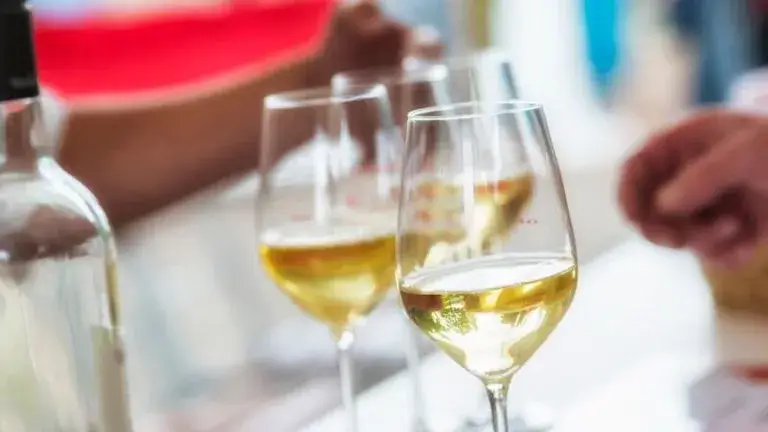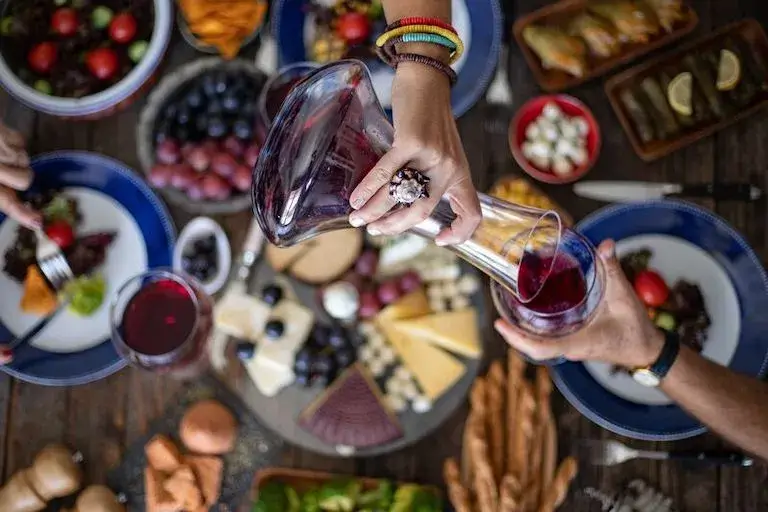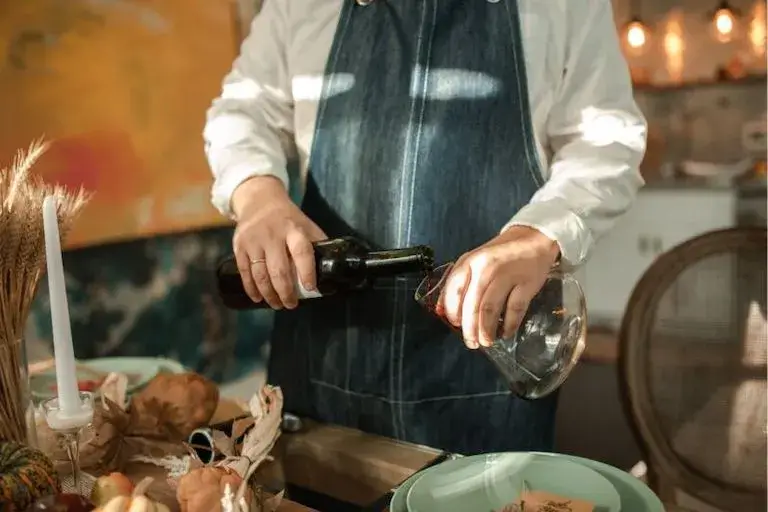Listen to This Article:
Once, wine lists felt more like pop quizzes than invitations. You’d scan a page of French words, furrow your brow, and hope the sommelier didn’t judge your choice. Back then, it was all stiff sommeliers rattling off notes about “terroir” and “mouthfeel.”
Today’s somms are flipping the script. They’re swapping intimidation for conversation and making wine feel personal, creative, and fun. Whether they’re pairing wine with tacos, breaking down Champagne versus Prosecco on TikTok, or spotlighting local wines, they’re reshaping how we talk about—and teach—wine.
And for culinary students, that shift opens new ways to connect with guests, whether in the kitchen, on the floor, or online.
Here’s how this new generation is changing the game.
From Gatekeeping to Guiding
Wine sales among younger consumers have been slipping. In 2024, only about 20% of wine consumption came from people under 40, according to Silicon Valley Bank’s State of the US Wine Industry report. Many in the industry point to wine’s reputation for feeling formal, intimidating, or out of touch.
That’s why today’s sommeliers are stepping into new roles: part guide, part storyteller, part friendly resource. Whether they’re helping a guest pick a bottle or sharing pairing tips on Instagram, they’re making wine feel more open, approachable, and relevant. Here’s how:
Old Guard vs. New Energy
For a long time, sommeliers were seen as formal experts. They were keepers of deep, often intimidating wine knowledge. But that image is shifting. More and more, today’s wine professionals treat wine like a conversation, not a competition.
In practice, this can look like a friendly guide who asks what you like, pulls up a chair, and offers a pour that fits your vibe, not just your meal—not someone standing tableside, reciting textbook notes, and telling you what you should be drinking with that entree.
From Fine Dining to Pop Culture Labels
Take André Hueston Mack, a self-taught sommelier who worked at The French Laundry and Per Se before launching his own wine label, Maison Noir Wines. His mission? Make wine fun, culturally relevant, and accessible beyond the walls of fine dining.
Traditionally, wine labels leaned on family names, châteaus, or regional classifications—think Château Margaux, Domaine Leflaive, or Barolo DOCG. These names signaled heritage and prestige but often felt distant from everyday drinkers. And sometimes, they were even hard to remember, despite how good the wine might have been.
Mack’s labels rewrite the narrative. His bottles feature bold, unmistakably personal names like “Love Drunk,” “Gamma Ray,” and “Knock on Wood.” His branding taps into hip-hop references, streetwear design, and humor that speaks directly to a broader audience. On social media, Mack shares behind-the-scenes stories, unexpected pairings (like rosé with pizza), and candid advice—bridging the gap between sommelier and everyday wine drinker. He also directly engages with his audience, asking what topics they want to learn about when it comes to wine.
Real Talk, Not Jargon
You won’t catch Mack—or peers like Michelle Chen, who blends wine education with pop culture, or Isis Daniel, known for her approachable, on-camera tastings—overcomplicating things with textbook terms like “mid-palate weight” or “unctuous tannins.” Instead, you’ll hear words like juicy, funky, smashable, or chillable. It’s language that’s fun and engaging, inviting people in.
One favorite? Glou glou (pronounced “gloo gloo”), a playful French term that mimics the sound of wine being poured or gulped. It’s used to describe light, easy-drinking wines meant for pure enjoyment and not much fuss. The phrase sums up this new attitude perfectly: wine that’s fun, unfussy, and shared without pretense.
It’s a shift happening everywhere, from restaurant menus to neighborhood wine shops. A skin-contact wine (made by fermenting white grapes with their skins for extra color and texture) might be described as “like peachy kombucha,” while a chilled red gets billed as “made for taco night.” These simple, approachable descriptions help take the pressure off and invite curious drinkers to explore.
How Sommeliers Are Talking About Wine Today
| Language Out | Language In |
|---|---|
| Terroir | Sense of Place |
| Mid-palate weight | Juicy, Lush |
| Unctuous tannins | Grippy, Smooth |
| Approachable | Easy-drinking, Smashable |
| Minerality | Fresh, Crisp or Funky (for wild notes) |
| Nose | Smells like… |
| High acid | Bright |
| Structure | Balance |
| Drinkable | Glou Glou (for light, fun wines) |
| Crowd-pleaser | Picnic-ready, Porch-pounder, i.e. location or situation specific |
| Skin-contact | Orange wine, white wine made with the skins |
Redefining Wine Culture: The Voices Leading the Change
The shift Mack helped spark with his social media reels and approachable video series isn’t happening in isolation. Across the wine world, a diverse generation of sommeliers, educators, and wine professionals—from Jamie Griffiths’ no-pretension tips to Tyler C.’s playful pairings, Monique Soltani’s globe-trotting storytelling, and Vivian Gay’s approachable deep dives—is expanding the conversation, bringing fresh perspectives, global palates, and new ways of thinking about wine.
Making Wine Feel Like a Shared Table
Alice Achayo, founder of The Wine Linguist and a Wine Enthusiast Future 40 Tastemaker, noticed early on in her wine journey that traditional wine language often left people out. Raised on the bold, layered flavors of Ugandan cooking, she rarely saw her palate—or those of many others—reflected in the way sommeliers talked about wine.
Her journey into wine wasn’t a cinematic “one perfect glass” story. It began behind the counter of a Boston wine shop, after years as a bread baker and a semester abroad in Italy, where she saw wine woven naturally into daily life, shared around tables without pretense.
Back in the U.S., though, she encountered a different reality.
“There was no cultural connection—just prestige and intimidation. Consumers second-guessed their palates and were even afraid to pair wine with food for fear of ‘doing it wrong,’” she says. “I wanted wine to feel like the dinner tables in Italy… I wanted friends and families to come together, to eat and drink and not overthink it.”
That insight led her to create The Wine Linguist—a platform focused on redefining wine culture through storytelling, education, staff training, and curated tasting experiences. Achayo helps both wine professionals and everyday drinkers connect to wine through their own taste memories and cultural roots.
In one post, she coaches a friend through tasting notes, encouraging her to use words that actually mean something to her. In another, she challenges the idea of lumping cuisines together—like recommending Riesling for all “Asian food”—and instead offers thoughtful pairings for specific dishes, such as Southern Thai cuisine, honoring both flavor and cultural nuance.

Tasting is learning—no fancy jargon required.
Learning by Tasting, Not Memorizing
For Chef Gregory Bonath, certified sommelier and Academics Operations Manager at Auguste Escoffier School of Culinary Arts, wine education isn’t about memorizing grape lists. It’s about tasting, asking questions, and staying curious.
His advice to students? Don’t overthink it. Start with what’s in front of you. Taste a wine, ask where it’s from, who made it, how it was grown, and then start asking about how it pairs with food you know.
“As you move up in wine education, you don’t just memorize grapes,” Bonath explains. “You start understanding how every factor, from the angle of the sun to the soil’s moisture, shapes what’s in the glass. It’s not just about the grape. It’s the human side and the nature side, too.”
For future chefs, Bonath encourages taking that same mindset into the kitchen. If you’re highlighting a locally caught trout on the menu, why not talk about the grapes grown nearby, too?
It’s a simple shift from memorizing facts to making meaningful connections. Over time, this can change how students, and future sommeliers, share the story of what’s in the glass.
Teaching with Story, Not Just Stats
Albert Schmid, Certified Specialist of Wine, author of The Beverage Manager’s Guide to Wines, Beers, and Spirits, and Lead Instructor at Escoffier, took a similar path when he first started teaching. Handed a massive textbook packed with dense information, he quickly realized that students weren’t engaging with it.
“I would ask students, ‘Have you read this?’ And they were like, ‘No,’” Schmid recalls. “It had 36 chapters and an alphabet of appendices. I thought, if I could shorten that—distill it down to what students really need to know—that’s how I ended up writing my own book.”
Schmid’s focus on making wine (and beverage) education practical and approachable reflects a larger shift in the industry: from memorization to meaning, from rote facts to real stories. It’s about giving students and wine lovers tools they’ll actually use, not just facts to recite.
The Digital Revolution
Today’s wine culture is happening as much online as it is in tasting rooms. Sommeliers are building communities on Instagram, TikTok, and YouTube, making wine education accessible to anyone with a smartphone.
Mack can be found across Bon Appétit channels, whether on YouTube or TikTok, as well as his own Instagram.
Take the video below, for example, where Mack invites viewers through a virtual tasting of 20 varied Italian wines. He walks across bottle lines—Chianti, Barolo, Prosecco—breaking down regional styles, grapes, and what each wine communicates. Instead of complex wine-speak, he shares direct tips like “Look for this aroma because it’ll feel brighter with seafood.”
On TikTok, Mack regularly shares tips on Bon Appétit’s page:
- In one video, he walks viewers through how to use a wine key—step by step.
- Intimidated by opening a bottle of Champagne? Mack breaks it down and shows you exactly how to do it.
Each video is under a minute, casually shot but packed with insight. Mack brings authenticity by showing off-the-cuff takes, commentary on flavors, and even laughs at his own mistakes.
Or consider Amanda McCrossin (@SommVivant) on TikTok, who turns wine education into punchy, 60-second stories with big impact:
- In one recent video, she explains one of the biggest myths in wine and beef pairings, and shares what to pair with smashburgers, steak salad, or tacos, especially in the hot summer months.
- In another TikTok she explains the difference between champagne and prosecco, and another gives you 3 tips for ordering champagne at a restaurant for those special nights out.
These sommeliers are just a few examples of wine professionals treating social media like a tasting room without walls. Every post is an open invitation to ask questions, explore new bottles, and learn by doing.
But you don’t need a ring light or a wine certification to start building your confidence. Whether you’re following along online or stepping into a local shop, here are simple ways to get started—no jargon, no pressure.
Practical Tips for Wine Beginners
Ready to get into wine without the stress? Here’s how to start:
Drink What You Like
Forget what you’re “supposed” to enjoy. If you love sweet wines or can’t get enough bubbles—great. That’s your starting point, not something to grow out of.
- Pay attention to what excites you. Was it the fruitiness? The bubbles? The crisp finish? Make a mental note—or better yet, jot it down.
- Don’t worry whether it’s “serious” enough. Moscato, Lambrusco, rosé… these aren’t beginner wines. They’re legitimate styles with their own traditions and complexity.
- Let your palate evolve or grow naturally. The more you taste, the more you might notice your preferences shift. Maybe you’ll start liking drier wines or bolder reds. Use those changes as a guide for what to try next, not because someone says you’re “supposed to.”
- Use your favorites as a launch point. Love sweet Riesling? Try other off-dry whites like Chenin Blanc or Gewürztraminer. Big fan of bubbly? Explore sparkling wines from different regions.
Try the Three-Bottle Method
One of Chef Gregory Bonath’s favorite tasting tips is simple: pick one grape variety (say, Pinot Noir) and buy three bottles, each from a different region or country.
For example:
- Oregon Pinot Noir: often fruit-forward
- Burgundy (France) Pinot Noir: typically earthier with more subtle fruit
- New Zealand Pinot Noir: brighter, with herbal or spicy notes
Taste them side by side, even over a few days if needed. Notice how each reflects its place of origin—the flavors, structure, and feel. Over time, you can start picking up differences without cracking a textbook.
Here’s what to notice:
- Does the wine taste light or bold?
- Is it fruity, earthy, spicy?
- How would you describe how it feels? Does it feel soft, grippy, smooth?
Ask Questions
Great sommeliers and wine shop staff love sharing their knowledge and helping you discover something new. Don’t be afraid to say, “I really liked [this wine]. What else should I try?”
If you’re in a wine shop, mention what you liked about a previous bottle (e.g., “I liked how fruity it was” or “I liked that it wasn’t too sweet”). You’ll often walk away with a great recommendation and maybe a new favorite.
Skip the Fancy Stuff (For Now)
Swirling, sniffing, slurping… sure, there’s technique in tasting. But when you’re starting out, the most important thing is simply to pay attention to what you’re tasting. Is it tart? Sweet? Does the taste linger, or does it disappear quickly? Does it remind you of anything? How would you describe it to a friend?
Try this: Take one slow sip and ask yourself, “What do I notice first?” That’s how you can start building tasting confidence.
Find Your People
Wine is better when it’s shared. Whether it’s a local tasting class, an online wine group, or a few friends swapping bottles at home, tasting together can make it easier to learn. Look for tasting events at local shops, community centers, or virtual tastings through social media wine communities.
Keep Notes
Snap a pic of the label and jot down what you liked (or didn’t) and why. A handy way to do this is to just snap a photo of the label on your smartphone and save it to a notes app. Jot down a few lines, such as:
- What did you like?
- What didn’t you like?
- How would you describe it?
- Anything surprising?
Over time, patterns will emerge. You might realize you love wines from a certain region or grapes with a certain flavor profile, and remembering those wines will help you shop smarter next time.

Modern sommeliers embrace a more approachable style, often pairing fine wines with casual, communal dining experiences.
For Aspiring Sommeliers: Your Modern Path
Thinking about turning your love of wine into a career? As wine culture shifts, so does wine education. The formal path still matters—the Court of Master Sommeliers maintains its four-level certification process, with the notoriously brutal Master exam boasting a 10% pass rate. But today’s aspiring sommeliers are finding more varied, creative ways to build their knowledge, whether they simply want to deepen their expertise or, if they choose down the road, prepare for certification.
The path is more flexible (and more creative) than ever.
- Mix and Match Your Learning. Formal programs can help—but it’s not the whole story. Read. Taste. Visit wineries. Work in the industry. And don’t underestimate the power of culinary education. Understanding how flavors interact, how food transforms, and how textures, acids, and aromatics play together can be huge when it comes to tasting wine and mastering pairings.
- Start Where You Are. You don’t need to start at a Michelin-starred restaurant. Bartend, work retail, or serve anywhere with a thoughtful wine list. Every pour can teach you something.
- Build Your Brand. Your voice is your superpower. Share it—whether through TikTok, Instagram, a newsletter, or a blog.
- Stay Curious. Always. New regions. New grapes. New ways of thinking about taste and tradition. The best sommeliers never stop learning.
- Lead with Hospitality. Knowledge opens doors, but making people feel seen and welcomed? That’s what sets great sommeliers apart. Instead of asking, “Are you looking for a bold red tonight?” try, “What kinds of wines do you usually enjoy?” or “Anything you’ve tried lately that you liked?” This can open the door for a conversation, and puts the focus on what they might like to drink.

Today’s sommeliers focus on flavor, not formality.
The Future of Wine Culture
The revolution in wine culture is just getting started. As more diverse voices step into the sommelier world, wine is becoming more inclusive, more creative, and a lot more fun. The focus is shifting from exclusivity to community, from intimidation to education, from showing off to sharing joy.
Whether you’re a curious beginner or an aspiring sommelier ready to make your mark, there’s never been a better time to join this movement. Want to build a career around flavor, hospitality, and the joy of sharing great food and drink?
A culinary education from Escoffier can offer a strong foundation in the principles of flavor, technique, and hospitality. If you’re interested in finding out more, contact us to explore which of Escoffier’s programs, could be a good fit!
ENJOYED THIS ARTICLE? TRY THESE NEXT:
- Restaurant Management 101: An Essential Guide
- How to Create a Great Beverage Menu
- 15 Careers in Hospitality Management You Can Pursue

